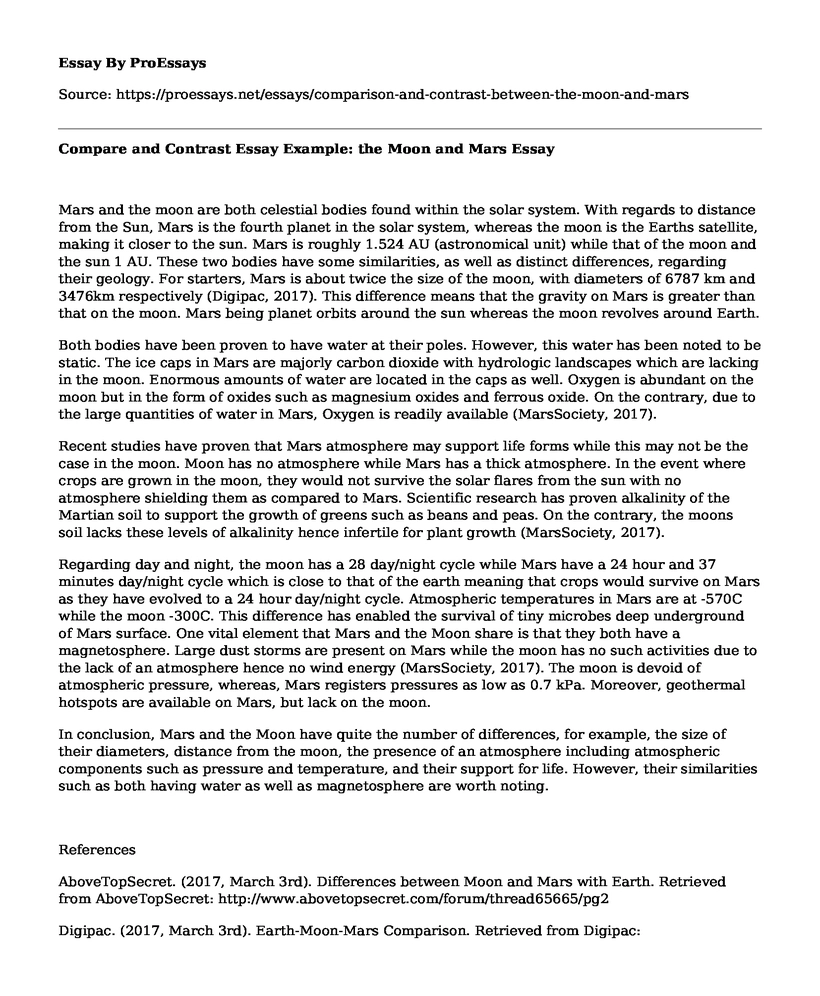Mars and the moon are both celestial bodies found within the solar system. With regards to distance from the Sun, Mars is the fourth planet in the solar system, whereas the moon is the Earths satellite, making it closer to the sun. Mars is roughly 1.524 AU (astronomical unit) while that of the moon and the sun 1 AU. These two bodies have some similarities, as well as distinct differences, regarding their geology. For starters, Mars is about twice the size of the moon, with diameters of 6787 km and 3476km respectively (Digipac, 2017). This difference means that the gravity on Mars is greater than that on the moon. Mars being planet orbits around the sun whereas the moon revolves around Earth.
Both bodies have been proven to have water at their poles. However, this water has been noted to be static. The ice caps in Mars are majorly carbon dioxide with hydrologic landscapes which are lacking in the moon. Enormous amounts of water are located in the caps as well. Oxygen is abundant on the moon but in the form of oxides such as magnesium oxides and ferrous oxide. On the contrary, due to the large quantities of water in Mars, Oxygen is readily available (MarsSociety, 2017).
Recent studies have proven that Mars atmosphere may support life forms while this may not be the case in the moon. Moon has no atmosphere while Mars has a thick atmosphere. In the event where crops are grown in the moon, they would not survive the solar flares from the sun with no atmosphere shielding them as compared to Mars. Scientific research has proven alkalinity of the Martian soil to support the growth of greens such as beans and peas. On the contrary, the moons soil lacks these levels of alkalinity hence infertile for plant growth (MarsSociety, 2017).
Regarding day and night, the moon has a 28 day/night cycle while Mars have a 24 hour and 37 minutes day/night cycle which is close to that of the earth meaning that crops would survive on Mars as they have evolved to a 24 hour day/night cycle. Atmospheric temperatures in Mars are at -570C while the moon -300C. This difference has enabled the survival of tiny microbes deep underground of Mars surface. One vital element that Mars and the Moon share is that they both have a magnetosphere. Large dust storms are present on Mars while the moon has no such activities due to the lack of an atmosphere hence no wind energy (MarsSociety, 2017). The moon is devoid of atmospheric pressure, whereas, Mars registers pressures as low as 0.7 kPa. Moreover, geothermal hotspots are available on Mars, but lack on the moon.
In conclusion, Mars and the Moon have quite the number of differences, for example, the size of their diameters, distance from the moon, the presence of an atmosphere including atmospheric components such as pressure and temperature, and their support for life. However, their similarities such as both having water as well as magnetosphere are worth noting.
References
AboveTopSecret. (2017, March 3rd). Differences between Moon and Mars with Earth. Retrieved from AboveTopSecret: http://www.abovetopsecret.com/forum/thread65665/pg2
Digipac. (2017, March 3rd). Earth-Moon-Mars Comparison. Retrieved from Digipac: http://www.digipac.ca/chemical/mtom/contents/chapter1/marsfacts.htm
MarsSociety. (2017, March 3rd). Mars versus the Moon. Retrieved from MarsSociety: http://education2.marssociety.org/mars-versus-the-moon-issue-19/
Cite this page
Compare and Contrast Essay Example: the Moon and Mars. (2021, Apr 12). Retrieved from https://proessays.net/essays/comparison-and-contrast-between-the-moon-and-mars
If you are the original author of this essay and no longer wish to have it published on the ProEssays website, please click below to request its removal:
- Challenges Facing Dubai - Research Paper Summary
- Research on Extraterrestrial Life
- Theory of Probability Paper Example
- Why Do Bridges Ice Before Roads? Essay Example
- Paper Example on Laminar and Turbulent Flow in Smooth Pipes
- Mass Spectrometry for Determining Substance Concentrations in Individuals - Essay Sample
- Essay Example on Chemical Revolution: A Historical Overview of the 18th Century







